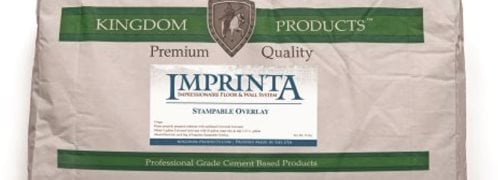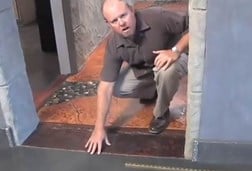- Concrete Overlays Home
- Get the Look - Interior Overlay Pictures
- When to Use a Polymer Overlay
- Comparison Chart of Overlay Systems: Which is best for your project?
- Five Factors to Consider when Choosing a Resurfacing System
- Concrete Overlay Reviews
- Types of Overlays
- Epoxy Coatings
- Microtoppings & Skim Coats
- Self-Leveling Overlays
- Spray-Down Toppings
- Polishable Overlays
- Stamped Concrete Overlays
- Preparing Concrete for Resurfacing
- Concrete Resurfacing
- Reducing Bond Failures Caused by Moisture-Vapor Transmission
- Don't Let Water Vapor Delaminate Your Overlay: How to seal concrete before an overlay
- How-To Tips for Installing Concrete Overlays
- Answers to Common Questions About Concrete Overlays: Advice from expert Chris Sullivan
- How to Add Color to Concrete Overlays
- How to Protect and Maintain Resurfaced Concrete
- Overlay Tools: Seven essential tools for concrete resurfacing
- Related Information
- Concrete Overlay Videos, with Bob Harris
- Decorative Concrete Overlays: A primer of the various overlay types and the decorative possibilities with each
- Vertical Concrete Overlays: Lightweight cement-based overlays mimic stone, brick, and other wall textures
CONCRETE OVERLAY PRODUCTS & MATERIALS
Here's an introduction to the various overlay types and factors to consider when weighing the optionsConcrete Resurfacing - Skimcoat Overlay Application
Time: 07:31
A concrete overlay allows you to give a sound surface a decorative facelift. A cementitious material is mixed and applied directly over the existing concrete. Overlays can be colored in a variety of ways, polished for a reflective sheen, or customized with stencils and stamps. Certain products are designed for use on indoor floors, while others are made to use outdoors.
Find Products: Interior Overlays & Toppings
Hire a Pro: Concrete Resurfacing Contractors
Even the best concrete can have cracks, discoloration, pop outs, and other flaws. While repairing concrete can help fix some of these, the repairs themselves can be noticeable and unattractive. It's no wonder, then, that many homeowners think their only option for improving the look of unsightly concrete is to rip it out and replace it. But if the concrete is in good condition otherwise, a decorative overlay is an economical alternative.
 Vapor Barriers for Existing Concrete Slabs
Don't let water vapor delaminate your overlay.
Vapor Barriers for Existing Concrete Slabs
Don't let water vapor delaminate your overlay.
 Comparison Chart of Overlay Systems
Easily compare popular concrete refinishing systems and find out which is best for your project.
Comparison Chart of Overlay Systems
Easily compare popular concrete refinishing systems and find out which is best for your project.
 Concrete Overlay Reviews
Get an inside look at the latest resurfacing systems from leading manufacturers.
Concrete Overlay Reviews
Get an inside look at the latest resurfacing systems from leading manufacturers.
 Concrete Squeegees & Resurfacing Tools
Seven essential tools to mix, spread, and finish concrete overlay products.
Concrete Squeegees & Resurfacing Tools
Seven essential tools to mix, spread, and finish concrete overlay products.
 Polished Concrete Overlays
Learn how contractors are taking advantage of this growing market niche for polished concrete.
Polished Concrete Overlays
Learn how contractors are taking advantage of this growing market niche for polished concrete.
 Epoxy Coatings
Get information on adding color and design to new or existing concrete with terrazzos, metallics and other coating systems.
Epoxy Coatings
Get information on adding color and design to new or existing concrete with terrazzos, metallics and other coating systems.
 Rapid Set Skim Coat
Repairs, levels, and smooths concrete for applications.
Rapid Set Skim Coat
Repairs, levels, and smooths concrete for applications.
 Thin Micro-Topping
Produces durable surface to color or stain
Thin Micro-Topping
Produces durable surface to color or stain
 Self Leveling Overlay
Find the overlay to meet your project's needs
Self Leveling Overlay
Find the overlay to meet your project's needs
 T1000 Stampable Overlay
For use with resurfacing concrete floors and hardscapes.
T1000 Stampable Overlay
For use with resurfacing concrete floors and hardscapes.
 Kemiko® Buildable Overlay
Decorative interior or exterior resurfacing
Kemiko® Buildable Overlay
Decorative interior or exterior resurfacing
 Flooring & Coating System
Epoxy Flooring System designed for concrete
Flooring & Coating System
Epoxy Flooring System designed for concrete
 Stamped Concrete Overlay
Warm weather and cold weather formulas
Stamped Concrete Overlay
Warm weather and cold weather formulas
 Imprinta Stampable Overlay
2-component system
Imprinta Stampable Overlay
2-component system
TYPES OF OVERLAY PRODUCTS
There is a wide offering of decorative overlays available on the market today, including systems that work for both interior and exterior applications, on vertical and horizontal surfaces, and at thicknesses ranging from that of a credit card to an inch or more.
- Microtoppings
These thin-section overlays, run the spectrum from spray deck products for driveways and pool decks to high-end trowel-grade materials for interior residential and commercial spaces. - Stampable overlays
Toppings that allow you to replicate the look of natural stone and other building materials on patios, driveways, floors or even walls. - Polishable overlays
Self-leveling or trowel applied overlays that produce a seamless flooring product that looks and feels like polished concrete or terrazzo.
Download a Free Report: Concrete Overlays Today
FACTORS TO CONSIDER WHEN CHOOSING AN OVERLAY SYSTEM
Selecting the most appropriate resurfacing system often involves weighing performance attributes against aesthetic value. Here are some questions to ask to help you find a system that will strike the perfect balance for the job at hand.
- What is the condition of the existing surface?
-
Does the concrete have a lot of cracks or gouges? Is the surface out of level? If so, choose a higher-build material, such as a self-leveling or stampable overlay that can be applied at a thickness of 1/4 inch or greater. Unless the surface imperfections are expertly patched or filled, they could telegraph through a thinner overlay, such as a microtoppping or skim coat.
Too much moisture in the concrete substrate can also be a problem for some overlay systems, especially products that restrict the ability of the concrete to "breathe" or release moisture vapor as needed. There are simple tests you can perform to check the moisture vapor emission rate of concrete. If it's too high, be sure to use a permeable overlay system that will permit the moisture vapor to escape. (Read more about reducing bond failures caused by moisture vapor transmission.)
- What conditions will the overlay be exposed to?
-
Be sure the topping or overlay system is tough enough to withstand all the conditions it will confront. Is the slab outdoors and subject to weather extremes and freezing and thawing? Is it a floor surface in a high-traffic area or subject to chemical, grease, and oil spills? Although most systems will stand up well to wear, chemical attack, and dirt penetration when properly installed and sealed, some are better suited than others for harsher exposure conditions. Often a higher-build material or a material containing aggregates will perform better in aggressive environments.
- What is the installed cost?
-
The total cost of overlay installation will be higher if you are using stencils, stamping mats, or decorative engraving or sawcutting to pattern the surface. Using more than one coloring method (such as integral color combined with broadcast pigments and stains or dyes) will also boost the final cost.
- How easy is the product to mix and apply?
-
Ease of use may also influence overlay selection, especially if you're the installer. Some products come preblended like a cake mix, and all you need to add is water. Others require mixing the polymer additive and any pigmentation desired with the cement and other dry ingredients. Some overlays can go right over properly prepared surfaces; others require application of a primer or bonding agent before overlay placement. Pourable, self-leveling systems tend to cover floors faster with less finish work than trowel- or spray-applied products.
- How much maintenance is required?
-
A decorative overlay should always be coated with a compatible sealer to help protect it from water penetration, stains, dirt, and grease. Sealed surfaces will also be much easier to clean. Floors typically require only routine sweeping to remove any abrasive particles and occasional wet mopping with a mild detergent, depending on how much traffic they receive. Occasional pressure washing may be needed to clean exterior slabs. Some overlay manufacturers recommend resealing surfaces annually, depending on the amount of traffic and exposure to freeze-thaw conditions.
- What look do you want to achieve?
-
Of course, the main reason to use an overlay system is to beautify existing concrete. Determine the color, pattern, and texture you want for your rejuvenated surface, and then find a product that can achieve the distinct look you desire. Consult with the overlay manufacturer and your installer for advice. Ask to see samples of various finishes and color selections as well as a portfolio of completed projects.
TIPS & TECHNIQUES FOR APPLYING CONCRETE OVERLAYS
Each contractor has their favorite application methods. Here are some expert insights:
- Prevent overlay failures with proper surface preparation, most products require a surface profile of CSP 3 or better
- Fill cracks with epoxy or polyurea materials that are rapid-setting and can be bulked up with sand
- Mechanical preparation, such as grinding with diamond cup wheels or diamond pads, is fast and effective
- Use a moisture-block epoxy primer seeded with sand to prevent delamination
- Trowel-apply microtoppings for a one-of-a-kind, handcrafted look
- Achieve smooth finishes by using a thin-blade squeegee like the Magic Trowel
- Help reduce inconsistencies, especially when working with integrally colored material, with larger batch sizes
- Work multiple thin layers of light-colored microtopping on top of each other, very much like Venetian plaster
- Apply diluted stains and dyes to accentuate the natural variations and marbling in the microtopping
- Make shallow decorative sawcuts to create a multicolored pattern in a microtopping floor
- Use terrazzo strips or other metal dividers for thicker-section overlays
- Apply a thin coat of microtopping over a stencil to provide an almost seamless two-dimensional graphic
- Fast-track polishable systems allow you to prepare the floor in one day, install and power trowel the overlay the next day, and polish the surface the third day
- Seed polishable overlays with different types of aggregate or colored glass
- Use high-solids polyurethanes, polyaspartics, or epoxies to seal overlays in high-traffic and commercial applications
- Stamped overlays often require aggressive mechanical surface preparation, along with the use of specialty primers
- Apply a stamped overlay in a neutral color then come back and lightly highlight the work to accentuate the texture in a very realistic manner





